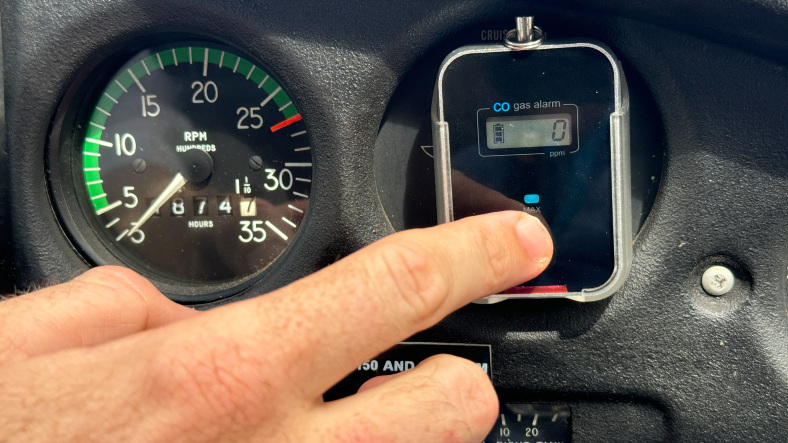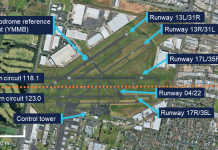Winter is here again, which makes now a great time to check that your carbon monoxide (CO) detector is working properly before heading out to fly this season.
Electronic CO detectors (also known as active detectors) come in all shapes and sizes, with the most common being small handheld devices that can be purchased from your local pilot shop or hardware store.
If you’ve recently purchased a detector, or are new to using a one, we’ve created a handy guide to help ensure your device is operating correctly so you’re not left out in the cold.
- Starting the device and understanding its display
Most detectors are simple and easy to use. Hit the ‘power on’ button to turn it on.
Familiarise yourself with the display, including the CO levels and any alarm indicators it might be showing.
- Testing the detector
Most CO detectors have a test button. Press and hold the test button to make sure the alarm works properly.
If nothing happens, the battery might be flat and need replacing, or the unit is defective.
Always make sure the battery is fully charged before your flight.
Depending on the unit uses a sealed battery that is certified for a finite time.
- Find the best position to place the detector
Carbon monoxide detectors work best when they’re placed as close as possible to where a leak might occur. In an aircraft, this is usually the heating vents.
It’s a good idea to mount the detector on the dashboard where you can see it easily and don’t have to pick it up to check it.
- Checking for CO levels
Carbon monoxide is measured in parts per million (ppm).
For a space the size of an aircraft cabin, 50 ppm or less is considered safe but that is for a fit and healthy person. Anything higher could start affecting you and your passengers with CO poisoning symptoms.
After you start the engine, you might see levels go up a bit, but that’s normal because there’s always some CO around when the engine is running, and more when taxiing.
- Understanding how the alarm works
Carbon monoxide exposure occurs more often during the colder months, when pilots are more likely to use cabin heating.
Most detectors go off when CO levels hit 50 ppm or higher, but some have a lower trigger point. You might be able to adjust the alarm sensitivity to avoid false alarms from low CO levels. Always treat any alarm as real until it has been determined to be false.
Some pilots like setting it lower to catch even small amounts of CO. If you decide to change your detector’s settings, CASA recommends not going above 50 ppm, otherwise you could be putting yourself at risk.
- What to do if the detector goes off
If you’re flying and the detector alarm sounds, turn off the cabin heater and open the vents to get as much fresh air in as possible. Let air traffic control know right away and start preparing to land as soon as possible (before things get worse).
Some GA aircraft have integrated or installed CO detectors that contain aeroplane flight manual instructions for use and actions in the event of CO indication or alarm. Pilots are required to be familiar with the normal and abnormal and emergency instructions.
Once you’re safely on the ground, get medical advice as soon as you can – even low levels of CO exposure can affect your health. CASA’s Carbon Monoxide poisoning fact sheet explains symptoms can include:
- headaches, dizziness, nausea
- muscular weakness, incoordination, and impaired judgement
- increased pulse, rapid breathing, chest pain
- unconsciousness, convulsions, and death if not removed from the exposure source.
If you are experiencing CO poisoning symptoms or have a high CO reading in the cabin, it is okay to make a PAN or MAYDAY call.
If you’re still on the ground when the alarm goes off, switch off the heater, open the vents and tell air traffic control. After they’re informed, taxi back to the apron and seek medical attention promptly.
Finally, make sure the cause of the problem is identified and fixed before further flight.
- It’s important to report safety incidents
Reporting incidents to the Australian Transport Safety Bureau (ATSB) is vital for maintaining and improving aviation safety. It supports proactive safety culture and ensures that lessons learnt contribute to safer operations. You can submit a report to the ATSB via their website.
If you’re flying for an air operator, you can also submit reports through their safety management system (SMS) incident reporting process.
Further information
Check out these resources for more information about carbon monoxide safety:
- CASA Airworthiness Bulletin – Preventing Carbon Monoxide Poisoning in Piston Engine Aircraft
- Flight Safety Australia – Carbon monoxide: a winter hazard
- Civil Aviation Authority (UK) – Carbon monoxide safety for general aviation





